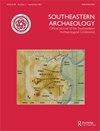与欧洲人接触的本土作物:阿肯色州Kuykendall Brake的仪式种子沉积物
Q1 Social Sciences
引用次数: 3
摘要
灵活的作物生产和野生食物采购策略帮助密西西比晚期农民抵御了欧洲接触前后的环境和社会动荡。到公元1400年,豆类已经被完全纳入人类社会,但由于保存的可能性很低,它们的经济重要性很难评估。同样,油质的本地种子,包括葵花和向日葵,在考古植物组合中很少有代表,到公元15世纪,栽培的葵花通常被认为几乎灭绝了。在阿肯色中部的Kuykendall Brake遗址,从一个被故意焚烧和掩埋的建筑中发现的仪式谷物祭品表明,在这种特殊的背景下,豆类的价值至少和玉米一样高。大型驯化的向日葵种子是第三种最常见的物种,从东南部其他地点获得的证据表明,这种作物并没有从所有的本土农业系统中消失。结合来自Kuykendall Brake的信息和来自该地区其他密西西比晚期和早期接触期的数据,我们得出结论,农业生物多样性的高水平和广泛的收获基础减轻了粮食不安全的风险,并帮助当地社会维持和延长了传统的生活方式。本文章由计算机程序翻译,如有差异,请以英文原文为准。
Native crops on the threshold of European contact: ritual seed deposits at Kuykendall Brake, Arkansas
ABSTRACT Flexible strategies of crop production and wild food procurement helped late Mississippian farmers withstand environmental and social perturbations that preceded and followed European contact. Beans were fully incorporated by AD 1400, but their economic importance is difficult to assess due to low likelihood of preservation. Likewise, oily native seeds including sumpweed and sunflower are poorly represented in archaeobotanical assemblages, with cultigen sumpweed often considered all-but-extinct by the fifteenth century AD. Ritual grain offerings from an intentionally burned and buried structure at the Kuykendall Brake site in central Arkansas indicate that in this special context, beans were at least as highly valued as corn. Large domesticated sumpweed seeds were the third most common species, adding to evidence from other sites in the Southeast that this crop had not been dropped from all Native farming systems. Combining the information from Kuykendall Brake with data from other late Mississippian and early Contact period assemblages from the region, we conclude that the high level of agrobiodiversity and broad harvesting base alleviated risks of food insecurity and helped local societies sustain and prolong traditional lifeways.
求助全文
通过发布文献求助,成功后即可免费获取论文全文。
去求助
来源期刊

Southeastern Archaeology
Social Sciences-Archeology
CiteScore
1.40
自引率
0.00%
发文量
25
期刊介绍:
Southeastern Archaeology is a refereed journal that publishes works concerning the archaeology and history of southeastern North America and neighboring regions. It covers all time periods, from Paleoindian to recent history and defines the southeast broadly; this could be anything from Florida (south) to Wisconsin (North) and from Oklahoma (west) to Virginia (east). Reports or articles that cover neighboring regions such as the Northeast, Plains, or Caribbean would be considered if they had sufficient relevance.
 求助内容:
求助内容: 应助结果提醒方式:
应助结果提醒方式:


